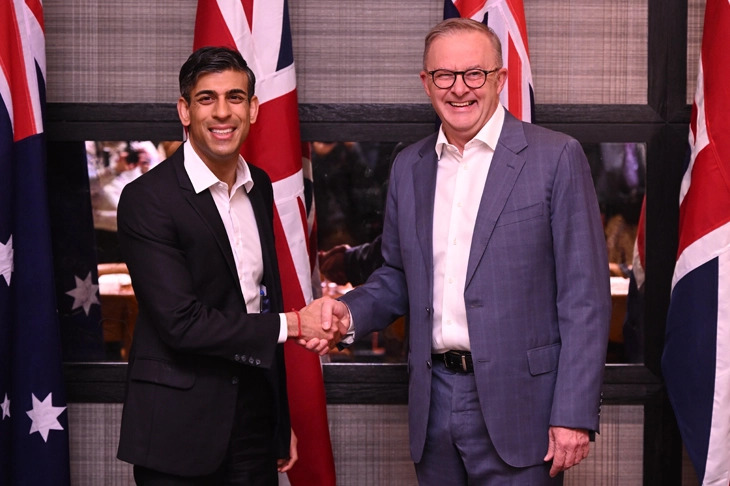In Australia’s three-ocean (Antarctic, Indian and Pacific) maritime zone of strategic interest, the Aukus nuclear propelled submarines will give greater reach, speed, manoeuvrability, stealth and punch. The new subs will be capable of longer continuous underwater at sea deployment, not needing to surface or return to home port for refuelling. The nuclear cores can run for the submarines’ lifetime and then be returned to the UK or US, with no need to build a domestic civilian nuclear industry. Although not doing so is a folly in eschewing clean, green and reliable power to assure energy security. Aukus re-integrates Australia’s two historic alliances, embeds both into its Indo-Pacific strategy, and builds a sea bridge between Nato and Aukus. President Joe Biden described the naval partnership as a critical instrument, at this ‘inflection point in history’, to stabilise the Indo-Pacific region at a time of rising tensions and the distinct possibility of a war over Taiwan.
All that said, six concealed minefields could yet sink the project. Many Australians, including Paul Keating, are uneasy at playing deputy to Sheriff Uncle Sam and turning China into a self-fulfilling enemy. He said on 15 March: ‘Anthony Albanese screwed into place the last shackle in the long chain the United States has laid out to contain China’. Chinese experts warn that the Australian Navy will become a de facto extension of the US Navy and consequently, Australia ‘has officially put itself on Beijing’s defence radar’. Second, national security experts believe that Australia faces the threat of war from China within three years. The first US submarine will be delivered only in 2032, the new Aukus class subs will become available in 2042, and the last in 2055. This is patently not fit for purpose. Australia’s looming capability gap has not been filled. Third, the $368 billion project budget is eye-watering. Going by the history of major defence acquisitions programs, the project will be completed substantially over budget and experience long delays. Australia will be the smallest of the countries with nuclear-propelled ships. Even Britain and France struggle with the costs of their nuclear fleets. Australia’s per capita costs to acquire and maintain its small fleet will be significantly higher. The post-Covid fiscal environment is already very challenging. The identity crisis for Labor is the trade-off required to reallocate public resources from ‘bread and butter’ to ‘guns and subs’.
Fourth, in that long timeframe, technological developments in underwater detection and surveillance capabilities could make the oceans increasingly transparent, destroying the only great advantage submarines have over other vessels. A study by ANU scientists concluded that submarines will lose their stealth and consequently ‘the submarine era will likely come to an end’ in the 2050s. While this is an important caution against irrational exuberance over the Aukus submarines, it possibly under-estimates potential technological developments by way of countermeasures in undersea warfare technologies. Investment in pillar 2 of Aukus with long-term plans to cooperate on quantum computing, AI, cyberwarfare and missiles is no less vital than acquiring the submarines. Fifth, operating just one class of nuclear submarines would be complex enough for a country with no previous experience with them. Operating two entirely different classes adds significantly to the complexity and cost, especially with so few subs in total. Also, the Aukus submarine will be of British design, with significant US technologies and components, and made in Australia. What could possibly go wrong? Industrial policy – the desire to create Australian jobs in return for the extraordinary financial outlay – works at cross purposes with security calculations.
Sixth, the net result of all these potential problems is that in their cumulative effect, the deal is subject to the multi-decade vagaries of volatile domestic politics in the three partner countries. With a different government and PM, as budgetary pressures mount, Australia could conceivably still cancel the planned eight Aukus submarines and order more US Virginias in their stead. With the infrastructure and supply chains already in place, it would be simpler and more cost-efficient to expand the US production line to build an extra five vessels. On 19 March Defence Minister Richard Marles confirmed that a commitment to help the US in a conflict over Taiwan had neither been sought nor given.
This could add to pressures in the interplay of US congressional and presidential politics to rethink the whole agreement in an America First strategy. Australia has also committed to managing all radioactive waste and spent fuel generated through the submarine programs in Australia. The federal government will face challenges in persuading one of the state governments to provide an appropriate site, and both governments will then have to manage robust public opposition.
Against these six potential problems that could scupper the Aukus subs, there are three other issues that have been raised in the public debate which, in my judgment, are more debating points than genuine obstacles. First, safety concerns are overblown. According to the White House ‘Fact Sheet’ issued at the time of the San Diego announcement: ‘For over 60 years, the United Kingdom and United States have operated more than 500 naval nuclear reactors that have collectively travelled more than 150 million miles – the equivalent of over 300 trips to the moon and back – without incident or adverse effect on human health or the quality of the environment’. Second, there is not the faintest hint of any Australian interest in acquiring nuclear weapons. The propulsion systems of the Aukus subs will be nuclear but the vessels will not carry any nuclear bombs. Yes, this sets a precedent and some other countries also could develop an interest in getting nuclear-powered subs but the steady improvements in the technology of warfare is part of the historical trajectory. The primary drivers of defence acquisition programs are local security concerns, not a desire to mimic Australian policies.
Finally, sovereignty concerns are also overstated. They will be Australian submarines, operated by Australian crews, commanded by a RAN officer and taking orders from the government of Australia. The decision to go to war will still be made in Canberra.
The expressions of concern ignore the historical reality of how just often Australia has been at the forefront enthusiastically signing up to be part of yet another coalition of the willing. Conversely, the Aukus allies have entered into an arrangement of pooled sovereignty. Both in granting privileged access to sensitive nuclear technology for the first time in 65 years (the last was to the UK in 1958), and also in agreeing uniquely to give 3 to 5 Virginia class submarines to Australia, the US too has compromised with its own absolute sovereignty.
Source : Spectator
















